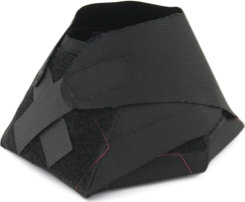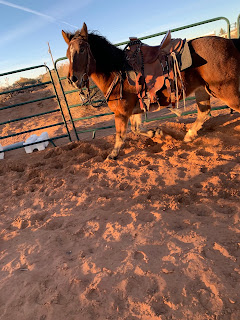Melissa wrote to me about her 10 year gelding who is always spooking and what she could do as he is not getting better at it. I wrote back to her to find out more specifics and she elaborated that her horse is very sensitive to all new things, particularly loud noises, and, vehicles and horses coming into his view. She asked what desensitization methods should she try. It's always hard to give advice on a horse you haven't seen but this is pretty much what we talked about.
It's tough to have an overly sensitive and spooky horse. Sometimes we when we handle those horses we get anxious about their new big spook, expecting it at any moment, and the horse can feed off of our energy, making it more likely for them to expect something to scare them. I can't emphasize this enough - if you think he's going spook, he most surely will.
On desensitization of horses, there are as many different views as their are people. And I'm not really fond of that word to describe what I do, but it's pretty much accepted that desensitizing is exposing the horse to stimuli that would create fear or anxiety in the horse and letting him work through it. I'm also not really happy with the title of this article "Spooky Horse? Teach them to think" because we are not really teaching then to think, just allowing them the time to find another way. Desensitization is not about getting a horse to walk over a ground tarp then having that horse desensitized for all ground tarps in the future, anywhere you go. I like to think that exposing your horse to anything scary is just a opportunity on setting it up for that horse to learn to think before reacting.
It may be correct to say that if something scares a horse, they need more of it not less, but it is also correct to say it's how you go about exposing the horse to that scary thing that'll either help him or make it worse.
The sometimes a human's first instinct when something scares the horse it to take the scary thing away or to remove the horse from that environment. You see this with people flagging a horse where if a person shakes a flag and the horse shies or moves away, the human removes the flag from the equation.
I recently demonstrated this at a clinic I ran a few weeks ago where I had a horse in hand who had never been flagged. I was using a rope halter and a 12 foot lead rope. I stood holding the horse about one foot away from the halter and used my outside hand to shake a flag with a lot of energy. The horse spooked and I stopped shaking the flag. I told the attending riders that all I did was teach the horse that getting away from the flag was the right thing to do.
Then I again started shaking the flag with energy and the horse tried to get away. I kept shaking the flag as we moved around for about 20 seconds ago. I stopped moving the flag while the horse was still trying to get away and once I stopped shaking the flag the horse stopped, but this body position and head set was real obvious that he expected me to start back up again. I told the riders that if I quit now, I would have done nothing to help that horse, instead just reinforced to the horse that trying to get away removes the scary stimulus.
Then I demonstrated what I thought would be a better approach. I gave the horse about 8 feet of slack in the lead rope and started shaking the flag in a slower fashion. The horse was at first stationary but the mental pressure in him built up pretty quick and he started moving away. I kept shaking the flag until the horse had all four feet momentarily stopped, then I immediately quit shaking the flag giving the horse a release as I explained to the riders that once the horse gave me the response I was seeking, all four feet stopped, I gave him a release from that pressure, and most importantly, I am giving him a pause to think about what just occurred, which was his acceptance of the flag. But this is not a conclusion - it is the very beginning.
I started back up again and the horse moved off like just before, but he got stopped quicker than before and was licking his lips. I gave him 10-15 seconds of pause then continued and I gradually took in the slack on the lead rope until I was at the horse's shoulder and was moving the flag with energy off his body and touching the horse on the belly, back, neck and rump with the flag. So the difference was not going from 0-60 in seconds but instead taking the time it took for the horse to accept what you are asking. And if anyone had a stop watch on us they would see that really only maybe 10 minutes had passed. It you can't give your horse 10 minutes then what can you give him?
The exact same philosophy would help Melissa's gelding. If she is riding or leading him past some barrels or trash cans, or plastic bags, or a car, or even a bushel of dead racoons and the horse snorts, shies or backs away, then don't avoid that - instead use that and as much time as necessary to get the horse accepting of it. Just stand with the horse. Within 10-20 seconds or even 2-3 minutes the horse will take a step towards the scary thing - it seems like their curiosity trait just won't let them do otherwise. But the horse will stop again on it's own. But don't ask him to go forward, he likely will on his own accord - when he is comfortable. Repeat and soon the horse is all over the object understanding it's okay, building his confidence. You may have to do this 100 times,...maybe a thousands times on lots of different things, but it'll be worth it.
Something I heard Craig Cameron say 20 years ago sticks with me - he said that our job was to take the fear out of the horse. We can't do so by avoiding everything we think will scare him.


















No comments:
Post a Comment